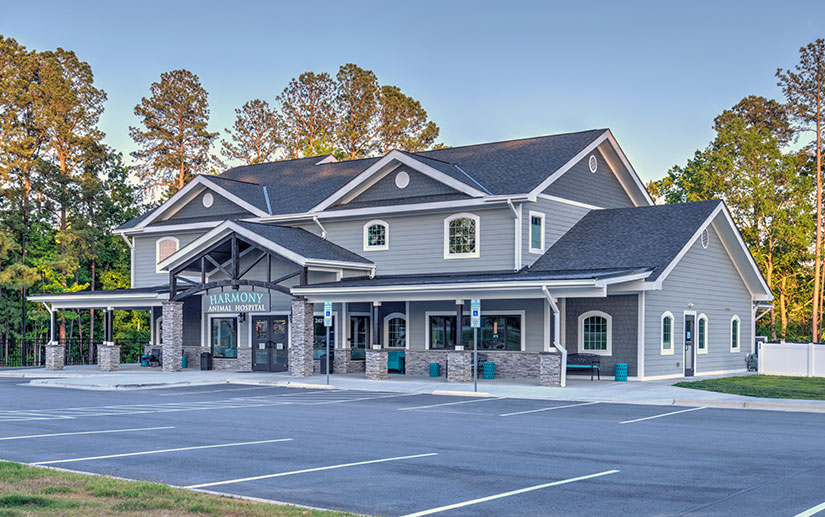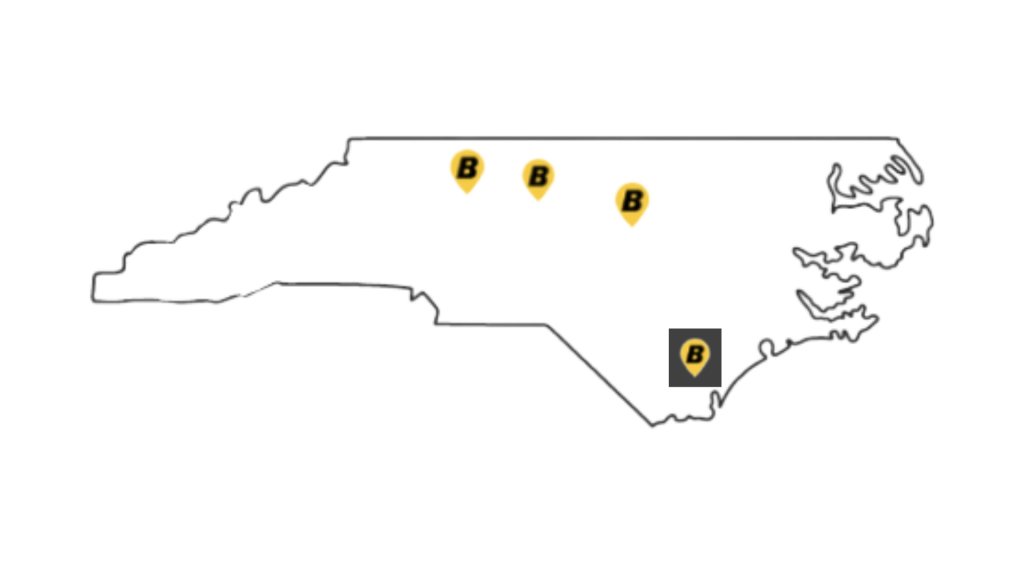People love their pets, so it’s no surprise that veterinarians are offering a variety of ways to pamper your favorite canine or feline. The high demand for quality veterinary services and amenities means that vet practices can often earn as much revenue on ancillary services as they do for medical services. Clinics are also considering the client experience and catering to high-end expectations. This is changing the mix of business as well as the requirements for modern veterinary facilities.
Bobbitt Design Build has long been a trusted source for veterinarians looking to build new clinics in the Carolinas. With decades of experience in veterinary clinic construction, Bobbitt has become an industry leader in designing and building modern facilities. Here are several recent trends we are seeing in veterinary clinic architecture and construction:
#1 Warm and welcoming atmosphere
Vet practices are striving to create a calm atmosphere for pets and their owners throughout their entire visit. From the exterior design to the interior layout and decor, many clinics today are taking on the look of a residential home or a traditional barn-style architecture rather than a stark hospital environment.
Inside the building, clinic lobbies have a warm, cozy feel to put animals at ease and create a smooth and relaxed experience.
#2 Noise and odor control
As any veterinarian knows, noise and odor control are always at the top of the list of considerations when building a new clinic. Odor control is a primary concern and must be addressed in the planning stages of construction.
“Special HVAC systems are placed strategically to control odors,” says Will Marshburn, Senior Project Developer at Bobbitt Design Build. “Should an accident occur, a well-designed air system will flush out the odor quickly without disturbing other clients.”
Noise control is also critical when designing a veterinary clinic. “Taking interior walls to the building structure to create sound barriers is one strategy we use in controlling noise. Acoustical ceiling tiles also work well in diminishing noise,” says Marshburn.
#3 Easy clinic flow
Another essential consideration when planning and designing a vet practice is the patient flow of the facility. What do you want your patients to experience during their visit? Where do you want them to spend the most time? What specific steps will patients take during a typical visit? These are all questions veterinarians must ask themselves when thinking about the flow of their particular clinic.
Designing for easy movement of staff, owners and pets throughout the facility will not only allow for a more efficient workspace, but it will also move clients in and out faster. According to Brian Griffith, Principal Architect at Bobbitt, “Veterinarians don’t want a cookie-cutter design. They need a unique layout that works for their individual needs and goals.”
#4 Modern features and materials
Many veterinary facilities incorporate special touches and modern design for a number of reasons. For example, clinics are accentuating outdoor views, making use of natural light, and going to full LED lights. They are also adding interior design elements, such as decorative wall panels, for ambiance. “Veterinarians are looking for natural and durable materials that can be easily cleaned while still looking fresh and aesthetically pleasing,” said Marshburn.
Vet practices are also choosing more environmentally friendly and sustainable construction materials. To maintain the health of their occupants, clinics are eliminating hazardous materials containing VOCs, including hazardous paints, adhesives, solvents, caulks, wood products, carpets and sealants.
Most practices are requesting green building practices to reduce or eliminate adverse effects and create positive impacts on the climate and natural environment during all phases of the clinic’s construction, as well as in its ongoing operation. Green buildings preserve valuable natural resources and improve the quality of life for those who occupy the building.
#5 New technologies
With new medical technologies readily available in the veterinary field, many clinics are taking advantage of integrating technology directly into the patient experience. Griffith explains: “Exam rooms are now technology-based, complete with large TVs to pull up x-rays, videos, patient records and more. Clients no longer have to wait in line to check out; instead, exam rooms are equipped with checkout capabilities.”
#6 Added revenue streams
As the animal care market continues to grow, veterinarians who once only offered medical care are now branching out into new products and services. Practically all new clinics include a retail area with high-end pet food, pet treats, supplements, toys and more. And capabilities such as dental, grooming, boarding, training, hydrotherapy and animal rehabilitation are now becoming new revenue streams for veterinary hospitals.
“Dental cleaning services have become one of the most popular new extensions to the traditional vet clinic. Veterinarians are requesting a designated room for dental cleanings, isolated from the rest of the practice,” says Marshburn.
Boarding and pet daycare is another revenue stream vets are exploring more and more. Many have individual pet suites where pets can experience luxury accommodations, as well as cat rooms with cat condos that link together.
When designing a pet boarding or daycare facility, outdoor space is a key consideration. New outdoor play areas include astroturf, pools and water features, covered areas and agility equipment. Zoning and site compliance can be challenging when building outdoor play yards, so choose a builder who has experience with permitting requirements and regulations.
Experience also comes into play when balancing the needs for the clinical areas vs. ancillary services. For example, veterinarians often want the grooming area to be visible, yet it is vital to keep grooming separate from the medical exam and treatment areas to avoid cross-contamination.
Veterinary clinic design-build in the Carolinas
With so many considerations going into the design and construction of a veterinary clinic, it is important to choose an experienced veterinary clinic builder. Bobbitt Design Build coordinates your project from beginning to end. Through planning, permitting, design and construction, your project is handled under one roof by a single point of contact.
“We enjoy creating animal clinics that fit the needs of the owners and staff,” says Griffith. “Throughout the design process, we use design technology to allow the client to virtually tour each room so they have a feel for the functionality of the space. We want to be sure we are creating what our client wants.”
Bobbitt has become a dependable source for veterinarians by staying at the forefront of the latest design trends. Contact Will Marshburn today for more information about how design-build can work for you next vet clinic project.


